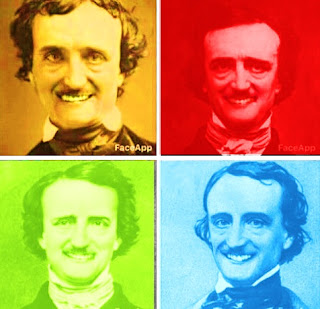Poetic Justice: The vindication of Edgar Allan Poe
 |
| Photographic images of Poe modified with FaceApp to show him smiling. |
If you have ever read any of the obituaries for Edgar Allan Poe published at the time of his death 170 years ago, you know that they generally lauded him as a knowledgeable and accomplished literary figure who had achieved national renown, but they also contained disclaimers such as he was controversial and not universally liked, as well as the inevitable observation that, because Poe died so young (40), his legacy seemed obviously incomplete. How would we update that analysis today?
Go to Wikipedia and you will know that Poe is regarded as a master of the macabre, the father of detective fiction, and an influential literary celebrity, if you will indulge the use of that term. However, Poe the poet remains a somewhat underdeveloped commodity, despite the fact that even the first obituaries acknowledged the popular success of “The Raven,” and his other poetry and essays about poetry have been influential with poets such as T.S. Eliot and Ezra Pound, and had an extensive influence over French poetry of the latter part of the 18th century.
Since poetry was Poe’s preferred medium, and because it is the particular beachhead of interest to this blog, let us review the Gothic Bard’s poetic legacy.
First, we must begin by acknowledging with the first obit-writers, that Poe’s poetic output was limited and some of it was incomplete. Poe himself concedes as much when he writes, “Events not to be controlled have prevented me from making, at any time, any serious effort in what, under happier circumstances, would have been the field of my choice.”
Poe’s oeuvre numbers some roughly seventy poems, only about a third of which were ready for prime time. However, Poe himself polished and reworked some of the earlier pieces to produce stronger poems such as “The Sleeper” (1841), “Lenore”(1843), “A Dream Within A Dream” (1849). More importantly, Poe’s later poems were consistently strong and included such classics as “The Raven” (1845), “The Bells” (1848), and “Annabel Lee” (1849). It is this trend that excites the imagination as we ask, what if Poe had lived another ten years or a quarter century more?
[Earlier this year, this blog ranked all of Poe’s poems into gold, silver and bronze classifications.]
Second, truncated development notwithstanding, Poe left us a rich and varied body of poetic works, which can be classified as falling into three epochs: I. the childhood/early youth poems, dating from the 1820s (like “Tamerlane” (1827), “The Lake” (1827) and “Alone” (1829)); II. the late youth poems, spanning the 1830s to the early 1840s (including “To Helen” (1831), “To One In Paradise” (1833), and “The Haunted Palace” (1839)); and III. the final stage poems from the middle 1840s onwards (including “The Conqueror Worm” (1843), “Ulalume” (1847) and “Eldorado” (1848)).
The themes that permeate Poe’s poetry include: the “dead lover” motif which first appears in the late youth poems but takes over in the final stage poetry; the “dream” theme which runs consistently throughout, and the “lost happiness/lost hope” theme that weaves in and out amidst the two principal themes; and the “netherworld” setting of poems, especially during the late youth stage, that extend into the allegorical scenery for late stage works (like the “kingdom by the sea” setting of “Annabel Lee” or the “ghoul-haunted woodland” of “Ulalume”).
Third and finally, we must consider the distinctive poetic style of Poe’s verse. Poe was a master of rhythm who could summon the sonic potentiality of words to power—and sometimes overpower—his poetic constructs. Highly lyrical, the works are devised with metrical precision and reverberate from a measured understanding of mythological and psychological imagery. Indisputably, Poe attained a recognizable and indispensable voice in the pantheon of American poets; simply put, he is an American original, with a voice and viewpoint as unique and unmistakable as Vincent Van Gogh or Tim Burton.
Poe’s poetry embodies, as he himself would define it, “the rhythmical creation of beauty in words.” And that is a high compliment because it supposes that he accomplished what he set out to attain. One hundred and seventy years after his death, Poe’s poetic legacy has equaled the acknowledged levels of excellence of his other works.




Comments
Post a Comment